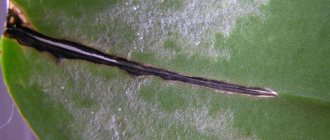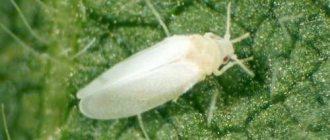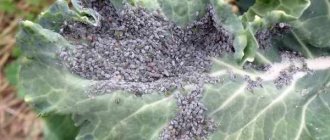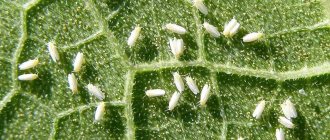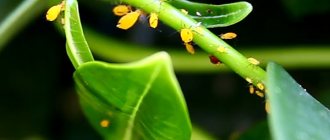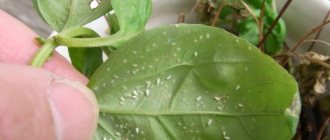Plants » Flowers
0
1673
Article rating
Kira Stoletova
Small white bugs appearing on an orchid are a common problem that almost all flower lovers face. Infection with mealybugs (often called hairy lice) without the necessary treatment leads to a gradual deterioration in growth and wilting of the plant, so it is worth starting to fight them much earlier.
Fighting white bugs on an orchid
Description and causes of pests
Mealybugs are small insects that feed on the sap of houseplants. The pests have an oval shape and a light-colored body, which does not exceed 6 mm in length. There are transverse grooves on the back of the parasites, and bristles along the perimeter of the body. There are 7 known species of scale insects, but orchids can mainly infect bristlecone and citrus fruits.
Male pests have transparent wings and can move freely from plant to plant. They do not have a mouthparts, since they live 2-4 days and do not need food, and die immediately after mating.
Female scale insects can have different colors depending on the species (white, pink, cream, etc.). They do not have wings, but have a proboscis designed for sucking juice from plants.
Females reproduce 3-4 generations of offspring in one season. The larvae that emerge from the eggs are voracious and molt quite quickly, turning into adults ready to reproduce.
Bugs can be located on buds, leaves, flowers and in the neck of the plant. By drinking the juice, parasites disrupt photosynthesis and metabolic processes, delay the growth and development of the flower, and make it vulnerable to diseases and infections (in particular, fungal ones).
Healthy orchids in comfortable conditions synthesize a special substance that repels pests, so proper care is the key to a beautiful plant.
The main reason for the appearance of insects on an orchid is improper care and inappropriate living conditions. First of all, this is waterlogging of the soil, high nitrogen content in the soil (with frequent fertilization) and uncomfortable air temperature. Parasites can also appear when fallen or wilted leaves are not removed in a timely manner.
Pests can enter the house with newly purchased flowers that were infected at a flower shop, as well as with untreated soil or cut bouquets
Briefly about white bugs
Mealybug is a pest of indoor and garden plants with a length of 3 to 5 mm. Its body is covered with bristles and a white powdery coating.
Females and males of insects have differences in behavior. The former are less mobile and form a white waxy airy yarn around their body. If you lift it, you can see the body of the insect and the yellow eggs laid.
Mealybugs close up
Mealybugs that pose a danger to orchids come in several types:
- Citrus mealybug (Planococcus citri). The female is pink, yellow or brown, oval in shape, reaches 3-5 mm in length, has bristles on the sides, and the body is covered with a powdery coating. The insect secretes a sweet secretion. The lifespan of an adult female is 90 days and is capable of laying about 300 eggs. Males are flying insects, similar in size and appearance to flies, with pink or yellow body color. The lifespan of a male is 2-4 days.
- Bristle mealybug (Pseudococcus longispinus). The female is orange or red, up to 5 mm long, the body is covered with a powdery coating, and long antennae grow on it. The female produces a large amount of secretion. Males are shaped like a fly, their body color is gray, and there is also a powdery coating on it.
For your information! Male scale insects do not have any function in procreation and are safe for the orchid. These insects reproduce without fertilization, so most of their population is female.
Other white orchid pests:
- whiteflies - insects 2 mm long, have wings and fly between the leaves, lay eggs on the underside of the leaf;
- spider mites - they envelop leaves and stems with white cobwebs;
- bulb mite - affects only the roots or the exotic point, promotes the development of fungus;
- Podura - settles only in the substrate;
- springtails - outwardly resemble lice, have a light or dark gray color, and can form in a substrate that contains moss.
Important! Before selecting treatment, it is important to determine the type of pest.
Signs of a flower being damaged by a parasite
The following signs will help you identify scale insects on an orchid:
- white fluffy coating on leaves, buds, substrate;
- small sticky droplets on the leaves;
- cobwebs left by female pests when laying eggs;
- plant rotting, loss of vitality and attractiveness;
- deformation of leaves, wilting and falling off of buds.
Orchids affected by the pest often suffer from fungal diseases, which aggravates the situation and accelerates the death of the flower.
The first signs of infection of a flower are the appearance on the leaves of small insects, sticky drops and white bags that look like small pieces of cotton wool.
What to do if white furry bugs appear on an orchid: how to get rid of them?
Have white furry bugs appeared on your orchid?
Most likely it is a mealybug pest. Under what conditions can it appear on orchids? What are the consequences of a mealybug infestation? We’ll talk about this and much more in this article, but for now let’s find out what are the first signs of infection by this pest?
small velvet oval spots appear on the tropical beauty ; there may be only a few of them - 1-2 pieces. However, this is already a serious reason to sound the alarm.
In this article we will tell you in detail what to do if white furry bugs appear on an orchid and how to get rid of them.
Mechanical pest control methods
Having identified an insect on an orchid, immediately begin saving the plant. First of all, isolate the sick flower and place it in quarantine to avoid the spread of infection. Then carry out mechanical cleaning:
- remove the affected buds;
- wipe the leaves with a cotton pad, removing cobwebs and pests;
- remove scales on the pseudobulb;
- cut off the top of the affected sprouts by 1-1.5 cm.
To save the orchid, conduct a thorough inspection of it, remove flowers, buds and affected leaves. Immediately take the infected parts of the flower into the trash can, and if possible, burn them.
After removing the damaged parts, treat the plant with a concentrated soap solution. The procedure for its preparation and use is as follows:
- Grate half a bar of dark laundry soap.
- Pour the raw material with settled or filtered water and stir well.
- Soak a cotton pad in the resulting foam and wipe it on both sides of the leaves, stem and peduncle.
- Treat the plant with a fungicide, avoiding contact with the soil.
- Wash the area where the treatment was carried out, the window sill and other surfaces where the infected flower was located with the remaining soap solution.
If the root system is damaged, immediately transplant the flower into new soil, having previously treated the roots
Where do midges come from in orchids?
If an orchid has midges, many gardeners are looking for the best methods to get rid of them. It is worth noting that insects choose favorable conditions for living, rich in food, as well as places with suitable conditions for reproduction.
The most likely reasons for the appearance of midges on orchids are:
- increased soil moisture caused by improper plant care;
- previously contaminated soil in which flowers are planted;
- seasonal appearance of midges that enter the house through open windows.
To prevent the appearance of insects before planting, you must carefully study how to properly care for them.
If it was not possible to avoid the appearance of pests, it is recommended that you become thoroughly familiar with the methods of combating them, which will allow you to save the plant in the shortest possible time.
Folk remedies
Folk remedies will help fight mealybugs. They are available and safe, but are ineffective against large-scale flower damage. It is justified to use home remedies in the initial stages of infection or for preventive purposes.
The most popular folk methods of struggle are as follows:
- soak a cotton pad in alcohol tincture of calendula and wipe the affected areas. Repeat the treatment until the parasites are completely removed;
- combine 3 tbsp. l. olive oil and 1 liter of water. Use the resulting solution to spray the orchid while fighting mealybugs and other parasites;
- mix 1 liter of water, 1 tbsp. l. liquid soap and 15 ml of ethyl alcohol. Use the resulting solution to wipe the affected leaves and stems of the plant, avoiding contact with the soil;
- dilute horsetail tincture in water (in equal proportions) and spray the orchid until the flower is completely cured;
- Fill a heat-resistant container with potato peelings, add water, bring to a boil and boil for 10 minutes. Strain the cooled broth and use it to spray indoor flowers;
- boil 1 liter of water, add a head of chopped garlic to the boiling water, boil for 2 minutes, and then let it brew for 5 hours. Strain the resulting infusion and use it to treat leaves and stems.
Folk remedies can be used to spray plants infected with the pest, as well as healthy flowers for preventive purposes.
Ways to fight
In order to prevent the mealybug from spreading to all pets, it is necessary not only to water the plant , but to carefully inspect it each time for the presence/absence of pests.
If this does happen, then :
- The orchid must be urgently isolated, making sure to check the nearby plants;
- Use cotton swabs to remove visible scale insects by wetting the sticks with vodka, calendula tincture or water;
- Give the orchid a hot shower at 40 - 50 degrees, which is destructive for mealybugs;
Traditional methods
When you don’t have chemicals at hand or don’t want to use them, you can prepare folk remedies :
- Garlic tincture . Crush or grate 5 cloves of garlic, pour in 0.5 liters of boiling water, leave for 4 hours, filter, brush the leaves and tubers with an undiluted solution;
- Vodka with soap . For 1 liter of water 15 g. liquid soap and 10 ml of alcohol or 20 ml of vodka. Apply to places where insects accumulate. It is necessary to first try on a small area of the orchid, since there are plants that are very sensitive to alcohol;
- Oil solution . 1 liter of warm water, 2 tablespoons of olive oil, mix thoroughly and spray the flower;
Folk remedies help fight mealybugs at home.
After these procedures, it is necessary to thoroughly blot the leaf axils and the growing point.
Mechanical cleaning
Without mechanical cleaning, getting rid of mealybugs will be very problematic. What does it consist of :
- Using a damp swab or cotton swab, clean the orchid from visible pests;
- If the peduncle or buds of the plant are affected, it must be cut off and discarded;
- Old leaves leave dry scales on the stems/pseudobulbs - they need to be removed , as there may be clutches of eggs or mealybugs themselves. Remove the latter with a damp swab;
- Mealybugs love to settle on young leaves or sprouts of orchids, which contain a large amount of amino acids. It is quite difficult to remove the pest from there. You can try to do this with a toothpick or soak an orchid removed from the substrate in a soap solution - the scale insects will come out on their own;
You can remove mealybugs yourself at home.
To prevent re-infestation, the window sill and glass are washed with detergents , and the curtains are washed. The plant can be treated with fungicides.
Chemicals
Chemicals are available in two types :
- Granules or sticks . This is not suitable for orchids due to the composition of the soil in which they grow and the fertilizer content in the preparations themselves;
- Liquids or emulsions . Oil emulsions are applied to areas where insects sit. But you need to know : since oil clogs the stomata of plants, this leads to the death of flowers in large areas affected by the pest.
In turn, liquid preparations are divided into:
- Contact - affecting pests upon contact with the insect itself, effective only on young individuals. These include Fozalon;
- Gastric - the insect enters the stomach through the mouth opening. Aktelik, Aktara, Vertimek;
- Systemic - when this remedy is used, the plant absorbs it into itself, becoming poisonous to parasites. Phosfamide, Rogor.
Substances acting on mealybug:
To be sure to get rid of mealybugs, it is necessary to carry out 4-5 treatments every 7-10 days with preparations with different active ingredients. During the treatment period, you should not keep the flower in bright sunlight.
Features of the use of insecticides
To save orchids, insecticidal preparations are used that quickly and effectively destroy pests and create a protective film on the surface. Chemical compounds are divided into three groups depending on the method of exposure. Detailed information about insecticides is presented in the table:
| Insecticide group | Method of influence |
| Intestinal | The insecticide enters the pest's body through the mouth, leading to paralysis of the nervous system and instant death |
| Contact | Toxic substances enter the body through the skin, which leads to the rapid destruction of pests. The product is effective in the fight against adult parasites, young parasites and larvae. The treated plant should be protected from sunlight to avoid yellowing of the leaves. |
| System | The active substance penetrates the root system of the plant and makes the juice poisonous to insects |
Procedure for using insecticides:
- Cover the treatment area with polyethylene and wash the flower with soapy water.
- Choose an insecticide. The most popular and effective include “Aktara”, “Mospilan”, “Fitoverm”, “Bankol”, “Aktellik”.
- Take safety measures - wear gloves, a respirator, a protective suit. Make sure there are no children or pets nearby.
- Carefully read the instructions for using the drug so as not to harm the plant.
- Treat the orchid according to the instructions and cover with a polyethylene cap to create a greenhouse effect.
- Carry out preventive treatment of healthy plants.
- After applying insecticides, wash your hands well with soap or disinfectant.
For complete recovery of the plant, three treatments will be required with an interval of 10-15 days. If possible, use different medications each time to achieve maximum effect.
Pest prevention
Mealybugs can cause significant damage to orchids. To avoid this problem, you must follow the recommended preventive measures:
- Before purchasing, carefully inspect the flower for infection. If the condition of the plant is in doubt, refuse to purchase it;
- keep the new flower in quarantine for 2 weeks to observe it and eliminate the possibility of the presence of parasites;
- regularly inspect your orchids to promptly identify and eliminate the problem;
- remove fallen buds, wilted or dried leaves in a timely manner;
- Maintain the optimal temperature for plants and follow the watering schedule.
To avoid infection of the orchid, provide the exotic plant with optimal conditions and proper care.
Insecticides and home remedies will help destroy the scale insects and save the orchid, the use of which requires strict adherence to instructions and safety measures. In order to minimize the likelihood of re-infection, provide the flowers with proper care and create optimal conditions.
Routes of infection
Mealybugs attack weakened orchids kept with poor care conditions .
Furry bugs appear on the orchid due to poor living conditions.
This happens when:
- Lack of natural sunlight;
- Low air humidity;
- Winter – short daylight hours;
- Moderate watering, especially for Cattleyas, Cumbrias, Cymbidiums, Dendrobiums and Carrots that are in a dormant period;
- Plants overfed with nitrogen fertilizers;
- Flowers arrived from distant countries that have not been treated with insecticides or quarantine.
Parasites rarely settle on healthy orchids , since they produce antibodies that repel insects.


